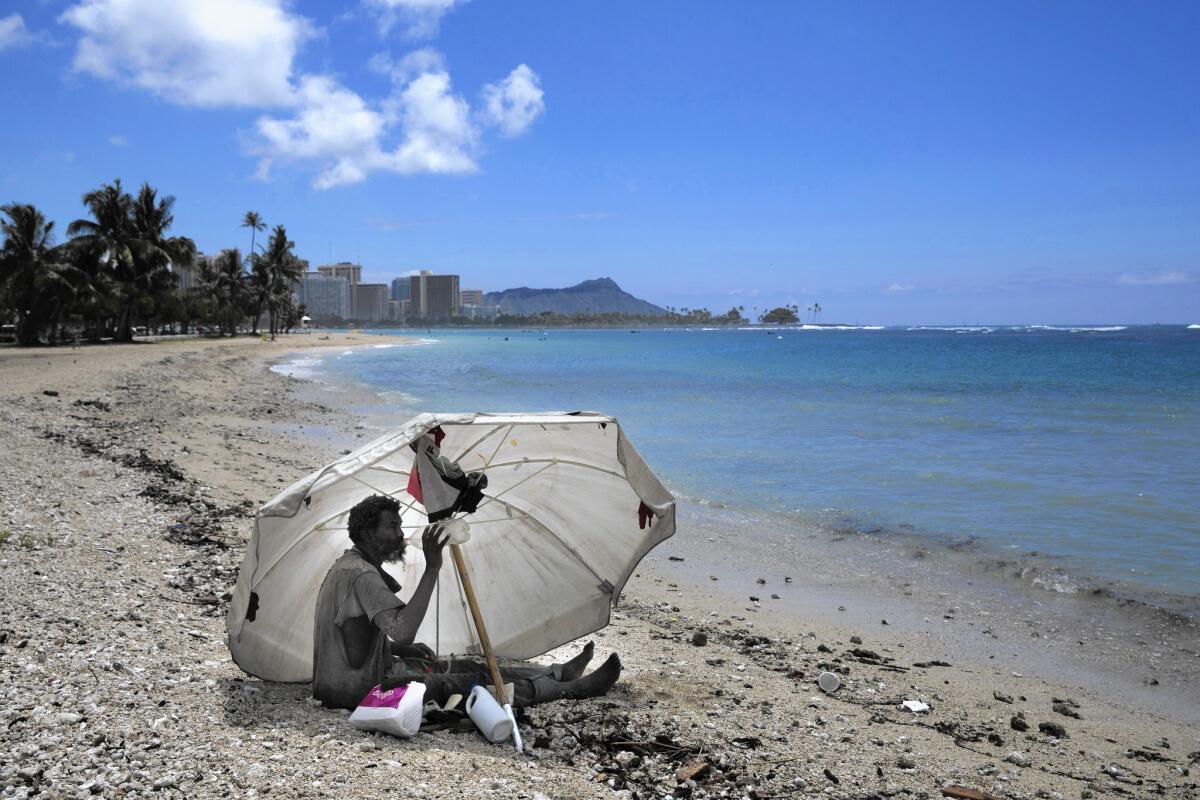Hawaii struggles to deal with rising rate of homelessness

Reporting from HONOLULU — Two days before the city planned to dismantle her sidewalk home, Kionina Kaneso had no idea where she and her daughter and grandchildren would sleep.
A full-time fast-food worker, Kaneso had bad experiences at shelters before and was hesitant to live in another, ending up instead in one of the nation’s largest homeless encampments. Desperate, she decided to try one again.
But there was no more space for families.
“Where can I go?” Kaneso asked.
Homelessness in Hawaii has grown in recent years, leaving the state with 487 homeless per 100,000 people, the nation’s highest rate per capita, followed by New York and Nevada, according to federal statistics.
Since 2010, the rise has come even as the national rate has fallen during the economic recovery.
The increase, driven by years of rising costs in the island chain, low wages and limited land, thrust the image of people sleeping on beaches alongside the state’s famed one of a relaxing tropical paradise.
Officials have tried to solve the problem. They’ve offered homeless services, banned sitting and lying on Waikiki’s sidewalks and proposed using shipping containers as temporary housing.
Gov. David Ige’s declaration of a state of emergency on homelessness in October underscored the depth of the crisis:
—While there are shelters and programs to help the homeless, there are far fewer empty beds than are needed — about 550 on any given night on Oahu, where an estimated 4,900 of the 7,620 homeless people live, according to service providers.
—The state needs 27,000 affordable rental units by 2020, but lawmakers set aside enough money for 800 units this year. Maintaining the existing public housing could cost $800 million over the next decade, according to state estimates.
—Statewide, 10,000 people wait five years or more to get into state-run public housing, and the waiting list for Section 8 rent assistance in private housing was so long, they closed the list for about a decade.
—The state’s population of unsheltered families ballooned 46% from 2014 to 2015, said Scott Morishige, state coordinator on homelessness. He said changes in public housing policy and mental health services contributed to the rise. A survey by service providers in August of Kaneso’s encampment found that 42% of the nearly 300 people were there with families.
Kaneso is among the many Micronesians who moved to Hawaii in recent years as part of an agreement their nations have with the U.S. government allowing them to work and live in the country. They come for medical care, education and job opportunities.
Kaneso arrived in 2004 and worked as a dishwasher and assembly line worker to pay for her son’s flight to Hawaii so he could get medical treatment for a heart condition.
Though the state doesn’t have a breakdown by race of the overall homeless population, data on homeless shelter use show that 30% were Hawaiian or part-Hawaiian, 27% Micronesian, Marshallese or other Pacific Islanders, and 26% white.
Micronesians say they face language barriers and discrimination.
For native Hawaiians, some of whom see the U.S. government as an occupier since a group of mainlanders overthrew the queen in 1893 and took over their land, the influx of other Pacific Islanders using services adds insult to injury.
“We should be helped first, because we really are suffering,” said Deja-Lynn Rombawa-Quarles, a native Hawaiian and camp resident.
The city tried to create a temporary safe zone in 2006 where the homeless could camp legally, but complaints ensued, so it ended up closing the park every night. Many of the homeless moved into hotel garages and walkways near Waikiki Beach.
Then the city banned sitting and lying down on sidewalks, a move backed by the Hyatt Regency, Hilton Worldwide and other major resorts, which generate much of Waikiki’s $6.8 billion in annual tourism revenue, nearly half of all visitor spending in Hawaii.
The hotels saw fewer homeless people, who then moved into other neighborhoods, prompting more complaints.
“People cannot camp and take over parts of our city and state property that has been built and designed for everyone, not one specific group,” said Honolulu Mayor Kirk Caldwell, after a group meeting on homelessness in September. “It’s not safe.”
Honolulu spends $15,000 a week to sweep away the camps. During the sweeps, families lose possessions, including the wood they use to build their structures, found furniture and clothes. Some have filed a lawsuit against the raids.
Service providers say 40% of Hawaii’s homeless people are working at least part time, 30% need some housing assistance, and 30% have mental health or substance abuse problems that prevent them from maintaining a home.
Kaneso’s job at a McDonald’s nets her $8.75 an hour, but it doesn’t come close to what she needs to pay rent in a market where a two-bedroom apartment goes for $1,800 a month.
Honolulu officials have set aside at least $16.8 million for services and to secure apartments for homeless people in 2015, including plans to develop units out of shipping containers to temporarily house transients on Sand Island and the Waianae Coast.
City officials also are backing at least $32 million in bonds to finance other housing for homeless people.
Bussewitz writes for the Associated Press.
ALSO
Portland’s rents are driving out the artists who made it cool
Researchers find origin of mysterious stone columns along Crowley Lake
El Niño ‘is here, and it is huge,’ as officials race to prep for winter
More to Read
Sign up for Essential California
The most important California stories and recommendations in your inbox every morning.
You may occasionally receive promotional content from the Los Angeles Times.










